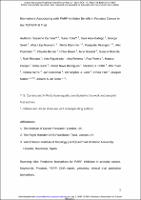Biomarkers Associating with PARP Inhibitor Benefit in Prostate Cancer in the TOPARP-B Trial

View
Author
Date
2021-05-27Permanent link
https://hdl.handle.net/11351/6114DOI
10.1158/2159-8290.CD-21-0007
ISSN
2159-8290
PMID
34045297
Abstract
PARP inhibitors are approved for treating advanced prostate cancers (APCs) with various defective DNA repair genes; however, further studies to clinically qualify predictive biomarkers are warranted. Herein we analyzed TOPARP-B Phase II clinical trial samples, evaluating whole exome and low-pass whole genome sequencing and immunohistochemical assays evaluating ATM and RAD51 foci (testing homologous recombination repair function). BRCA1/2 germline and somatic pathogenic mutations associated with similar benefit from olaparib; greater benefit was observed with homozygous BRCA deletion. Biallelic, but not mono-allelic, PALB2 deleterious alterations were associated with clinical benefit. In the ATM cohort, loss of ATM protein by immunohistochemistry associated with better outcome. RAD51 foci loss identified tumors with biallelic BRCA and PALB2 alteration while most ATM- and CDK12-altered APCs had higher RAD51 foci levels. Overall, APCs with homozygous BRCA2 deletion are exceptional responders; PALB2 biallelic loss and loss of ATM immunohistochemical expression associated with clinical benefit.
Keywords
Prostate; PARP; biomarkersBibliographic citation
Carreira S, Porta N, Arce-Gallego S, Seed G, Llop-Guevara A, Bianchini D, et al. Biomarkers Associating with PARP Inhibitor Benefit in Prostate Cancer in the TOPARP-B Trial. Cancer Discov. 2021 May 27;candisc.0007.2021.
Audience
Professionals
This item appears in following collections
- HVH - Articles científics [4471]
- VHIO - Articles científics [1250]
The following license files are associated with this item:

 Private area
Private area Contact Us
Contact Us







